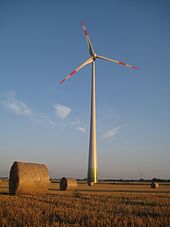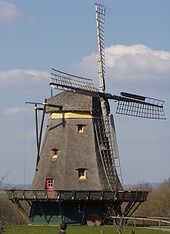Wind power in Germany
![]()
This article describes the technical use of the power of the wind; for the physical energy contained in the wind, see wind.
Wind energy or wind power is the large-scale use of wind as a renewable energy source. The kinetic energy of wind has been used since ancient times to make energy from the environment available for technical purposes. In the past, the mechanical energy made available by windmills was used directly on site to power machines and devices. With their help, grain was ground into flour, groundwater was pumped to the earth's surface, or sawmills were operated. Today, the generation of electrical energy with wind turbines is by far the most important use.
At the end of 2020, wind turbines with a nominal capacity of around 743 GW were installed worldwide, of which 35.3 GW were offshore. Not quite half of this capacity (about 347 GW) was installed in Asia and the Pacific, about 220 GW in Europe and about 170 GW in the Americas, while only a few GW were installed in Africa and the Middle East. In 2019, according to BP figures, the plants installed worldwide supplied about 1430 TWh of electrical energy; equivalent to about 5.3% of global electricity production. Its share of global primary energy consumption of (162,194 TWh), in which it tends to be under-represented due to the method of calculation, was 0.9%. On good sites, the electricity production costs of wind power plants were already cheaper than the electricity production costs of new coal and nuclear power plants in 2013. Depending on various factors, such as wind accessibility (meaning here: quantitatively and qualitatively suitable wind occurrence - on site) and turbine design, wind turbines achieve approximately between 1,400 and over 5,000 full load hours (the latter at the best offshore sites).

Typical wind turbine around 2009 (part of a wind farm for electricity generation)
History of wind energy use
→ Main article: History of wind energy use
It is disputed when the first windmills were erected. According to written records from the Codex Hammurapi, they were used more than 4,000 years ago, while other researchers consider their use to be documented as late as the 7th century AD. In Europe, the oldest mentions from England date to the mid-9th century AD, and in the 11th century they are attested in France. By the 13th century they had spread as far as Poland. Wind energy was used to perform mechanical work with the help of windmills and water pumps.
In Europe, several 100,000 windmills existed in the 19th century, which generated up to 25-30 kW of power in good wind conditions. In France, England, Germany, the Netherlands, Belgium and Finland there were between 50,000 and 60,000 windmills in the first half of the 19th century. Around 1900, there were about 30,000 windmills in operation in the North Sea countries alone, with a total capacity of several 100 MW. Windmills were particularly widespread in the Netherlands, where there were about 9,000 mills in the second half of the 19th century alone. The mills were used for grinding grain, spinning cotton and whitewashing cloth, and also as a source of power for punching leather, sawing wood, producing oil, paper and tobacco, and draining marshes or areas of land below sea level.
In Germany, the number of windmills continued to rise during the Industrial Revolution, initially until the period of high industrialisation, reaching its maximum in the 1880s. In the decades that followed, many of the windmills were successively replaced by fossil power sources or electric drives. In 1895, there were about 18,000 windmills in operation in Germany. It is estimated that about 11,400 were still operating in 1914 and 4,000 to 5,000 in 1933. Also significant were wind pumps; the multi-bladed Western windmills with a capacity of a few 100 watts were widely used. By about 1930, over six million Westernmills had been produced, with about 150,000 still in existence. Developed in the USA from 1854, Western windmills (eng. Western Mill) became widespread as water pumps in North and South America, Australia and parts of Africa, and were later used to generate electricity. There were about 1000 manufacturers of windmills in the USA, but they almost completely disappeared from the market after the boom.
After the discovery of electricity and the invention of the generator, the idea of using wind energy to generate electricity was obvious. The first wind turbines for electricity generation were built in the late 19th century and remained largely unchanged until after the Second World War, when the first larger turbines with a few 100 kW came onto the market. Since the oil price crises in the 1970s, there has been an increased worldwide search for alternatives to power generation, which has also spurred the development of modern wind turbines. In 1979, various Danish companies began to mass-produce wind turbines. Since the early 1990s, the wind industry has been one of the fastest growing industries in the world.
After the Second World War, several thousand Western windmills were built in the American-occupied territories in Bavaria and numerous in Upper Austria to pump water. Around 1958 and 1970 some were still to be seen, survived until today in Bavaria only one in Dietmannsried in the Allgäu. The one in Unterroithen in Upper Austria is the landmark of Edt bei Lambach and is symbolically represented in gold and 12-winged in the coat of arms awarded in 1980.

Windmill
Search within the encyclopedia